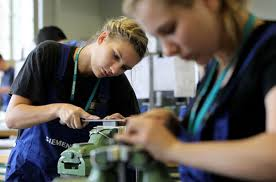
Image via onrec
A study by the American Association of University Women (AAUW) found that women are less likely to declare engineering majors than men. Even when women do pursue their engineering dreams, there is still a gender pay discrepancy that occurs for engineers who are performing the same efforts. A study at the American Society of Mechanical Engineers (ASME) stated that although there has been a significant increase toward pay equality, the median earnings of female engineers is $76,984 while male revenue is $96,000. A similar report by the AAUW suggests that women are less likely to land the engineering job of their dreams due to gender bias in the workplace. AAUW states that this is because of preexisting stereotypes that have arisen in society where fields of math and science are gendered toward the male sector, while females are often associated with the arts and liberal studies.
Electronic Products spoke with Sorock Kim, a civil engineering master’s student at NYU, about women in the world of engineering. Although she has not experienced blatant gender bias, she has found that “field engineering and construction management are not the most welcoming places for women engineers.” Kim presently works on the design side of civil engineering. Throughout her engineering career, the topic of gender bias in the industry has come up several times in discussion with other talented female engineers. Upon speaking with her colleagues she discovered that “one of them had actually wanted to become a construction engineer but chose to go for design engineering because she felt that as a skinny and short woman, she would have many 'invisible' restrictions in construction management.”
Over the years, Kim has observed the female-to-male engineering student ratio at NYU. She has discovered that “the ratio varies for different majors.” In her particular program, the female-to-male ratio varied from 0.2 to 0.4 in civil engineering classes,” and that this ratio “is higher in biomolecular and chemistry engineering, but lower in electrical and mechanical engineering.”
Kim feels very inspired by female engineers that have been her predecessors in the engineering world. She cites Dr. Anne Dudek Ronan, professor in NYU’s Civil and Urban Engineering department and Hi Sun Choi, senior principal at Thornton Tomasetti, as great sources of inspiration. “I have known Dr.Ronan since I was a freshman in college. I have taken several classes with her, and am currently working on my Master's Degree Project under her advice and guidance. Throughout all 5 years, she has continuously inspired me with not only her tireless dedication and passion as a professor but also great personality. She is probably one of the most honest and upright people that I have met.” Kim recently met Ms. Hi Sun Choi, declaring, “Before then, I only had known her as a successful Korean-American female engineer. Now that I got to know her, not only as a successful Korean-American female engineer but also as a great wife and mother in her family, she is a great encouragement and inspiration to me.”
NYU hosts a Women’s Summit each year as an initiative to empower, honor, and mentor women in the engineering fields. This program spreads STEM knowledge, leadership techniques, and activism in the female engineering community.
The National Academy of Sciences performed a study that determined that a team of research scientists at Yale would be more apt to offer lab managerial positions to men with a higher salary, making $4,000 more than women, even though the female applicants were equally adept and qualified for the exact same position. Senior researcher at AAUW, Christi Corbett, announced that “the study was done by researchers at Yale, but the subjects were research scientists, so they’ve been trained to be objective. They are also [from] top tier universities, so they are people at the top of their field, and yet these people still are offering less money to women than to men for the very same job, and women who are identically qualified. What that research points to is this implicit bias that we all have.” In order to close this pay gap, Corbett proposes that “changing the image of engineering could make it clear that engineers do, in fact, contribute to society in a meaningful way. This could go a long way toward opening girls’ eyes to the possibility of a career in engineering. Seeing women who are engineers can make a big difference too.”
Various groups have risen to promote awareness of engineering and how females can make a difference in the world and work through the imminent gender inequality. The High-Tech High Heels organization is dedicated to spreading awareness about the benefits of pursuing Science, Technology, Engineering, and Math (STEM) degrees.
Although society is still working on bridging the compensation gap and engineering equitability between genders, women have made significant progress in the engineering field. Prominent leaders in the industry like Marissa Mayer, Ruchi Sanghvi, and Sheryl Sandberg have opened great doors of inspiration for women who aspire to successfully become engineers.
Story via AAUW
Advertisement
Learn more about Electronic Products Magazine





